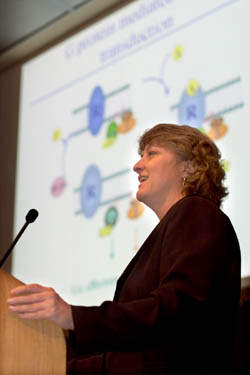
Heidi E. Hamm, Ph.D., chair of the department, has been appointed the first Earl W. Sutherland, Jr. Professor of Pharmacology. (photo by Dana Johnson)
Hamm appointed
Sutherland Professor
An afternoon of lectures by eminent scientists in the field of cell signaling marked the inauguration of the Earl W. Sutherland, Jr. Chair in Pharmacology, held by Heidi E. Hamm, Ph.D., chair of the department..
“It is very much of an honor to hold this professorship. Earl Sutherland is really the founder of my field,” Hamm said.
Sutherland, professor of Physiology at Vanderbilt from 1963-1973, was awarded the 1971 Nobel Prize in Physiology or Medicine for his discoveries related to cellular signaling and hormone action. He discovered the molecule cyclic AMP and developed the hypothesis that a hormone operates as a “first messenger” and causes the cell to produce a “second messenger” like cyclic AMP to carry the signal forward.
Though his work launched signal transduction research as a field, Sutherland probably never heard the phrase signal transduction, said Joel G. Hardman, Ph.D., professor of Pharmacology Emeritus, who came to Vanderbilt as a postdoctoral fellow to train with Sutherland. He certainly had never heard of the signaling molecules discussed by the symposium’s speakers, Hardman added.
“He would have been excited by today’s talks, and he would’ve been stunned by the progress that has taken place since his death,” Hardman said.
Hamm led the symposium with her presentation “Regulation of G Protein-Mediated Signal Transduction.” G proteins act as molecular switches in the process of transferring signals across the cell membrane. They switch on when signals like hormones interact with cell surface receptors. They switch off after passing the signal on to the next protein in the message chain.
G protein-controlled signals are key to numerous physiological process, especially in the brain where many neurotransmitters work by activating G protein-regulated cascades. During two decades of studies, Hamm has used multiple experimental approaches to understand how G proteins work – how they turn on and off, and how they interact with receptor proteins and with the proteins that are next in the message chain.
Because there are so many different types of G proteins that interact with hormone receptors, Hamm and colleagues have focused recent efforts on trying to understand the specificity of G protein signaling. Her laboratory has developed tools they call “mini-genes” to interrupt the signaling of each individual type of G protein. In initial studies, they are using the mini-genes to study thrombin receptor signaling in cultured endothelial cells.
“The mini-gene tools are uncovering an interesting complexity in signaling,” Hamm said. “We think they’re going to be very useful tools for discovering the molecular events underlying receptor and G protein action.”
Other speakers in the afternoon symposium on signal transduction included Lewis C. Cantley, Ph.D., professor of Cell Biology at Harvard Medical School; Lee E. Limbird, Ph.D., associate vice chancellor for Research and professor of Pharmacology at Vanderbilt; John D. Scott, Ph.D., senior scientist at the Vollum Institute and associate investigator of the Howard Hughes Medical Institute; and Joseph P. Noel, Ph.D., associate professor of Structural Biology at The Salk Institute.













